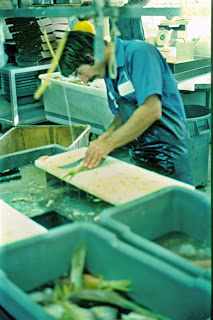
Larry was a heavy dude. Some said he’d been a biker for years. I knew he’d bummed around the Caribbean for a while. There were tales of smuggling of immigrants and such, although no one knew for sure if they were real or just talk. His rougher edges had been smoothed out to a degree when he shacked up with an artistic broad, a girl clever enough mentally and big enough physically to keep him under some degree of control. I knew him through her, so I suppose it was his softer side with which I was acquainted.
Still, there was talk that he popped a daily ten-milligram Valium tablet with his morning coffee, just to make sure that he could maintain a veneer of civility with his fellow man. In fact there were very few people that he could stand,. Out of a dozen or more Americans on the job there were only a couple that he could tolerate, by his own admission.
In addition to these peculiarities, he was also seemed to be one of the cheapest human beings I had ever met. The guys he lived with claimed he even had his
own roll of toilet paper that he kept with him, unwilling to chip in for a general supply, given the possibility that one or more of his companions might actually waste this commodity. Thus I was surprised to find out that he was spending large sums of money on pre-arranged Voodoo ceremonies.

The first hint of this came when I inspected his concrete form work before a pour. Strange symbols began to appear regularly, drawn on the outside of the plywood forms. At first I thought this no more than an artistic impulse on the part of one of his workers, similar to the graffiti we sometimes saw on urban walls at home. I made no mention of it, because Larry’s crew was working like a well-oiled machine, accomplishing a great deal of work and pouring a new section of the project almost every day. The drawings continued, and became more elaborate.
One day there was a relatively rare occurrence. A form “blew out” during a pour. The plywood (which we reused until it became too worn and weak) had ruptured due to the pressure of the concrete. The place where it broke was right in the middle of one of the drawings. I pointed that out to Larry, and his response was inappropriately vague. It wasn’t till one morning, after another successful pour, that we noticed a series of black banners waving from the reinforcing rods over Larry’s project that it became clear. Something funny was going on. I went down to talk with Larry.
That’s when the story came out. He would confide in me, but I was the only American, with the possible exception of his boss, Jim O’Brien, who should know about this. He’d been talking with his men about his likes and dislikes (and general paranoia), and they had suggested that he consult a kind of voodoo operative called a
bocor, who could cast spells and the like. For a nominal fee, the
bocor had provided him with a specific potion, which, when applied to the face, elbows, and knees, would give him certain protection or powers. He showed me a clear bottle filled with what looked like a Haitian moonshine called
clairin and various sticks and roots which I took to be herbs. He splashed a little out in his hand and spread it over his face, which I did notice had taken on an odd glow in the last month or so.

He’d felt that the initial contact with the voodooists was so successful that he had ordered another series of private ceremonies. He was instructed to drive to a certain place near a cemetery after dark, to park and wait. After a while a young boy came out of the woods, and without speaking led him through the dark along a series of paths. After an hour they emerged from the woods, and there were more graves and a mausoleum-like structure. Larry had the feeling that they were back near where they had started, but wasn’t sure. There they were met by one of the men on his crew, and several others who played the role of zombies. Inside the mausoleum was the
bocor. The crew member acted as interpreter. Voodoo dolls were set up representing various people Larry didn’t like, and they were stuck with nails, lit on fire with alcohol, and so on. Larry said at one point the
bocor covered his arms with alcohol and lit it, but miraculously he wasn’t burned. One of the curses he requested was that everyone on the job that he didn’t get along with (which was just about everybody) would be eliminated, in one way or another.

The next day I mentioned to O’Brien what Larry had told me. At one time in his life O’Brien himself had been fascinated with primitive religions, and had actually traveled to Jamaica, the Bahamas, Haiti, and (so he said) Brazil to study Afro-Caribbean religious beliefs. “Tell him what he is doing is incredibly dangerous!” O’Brien said. “He is fooling around with low-level psychic phenomena, and it will lead to nothing but trouble!”
I told Larry what O’Brien said, to little avail. "He actually thinks it's gonna happen!" That afternoon the whole American crew got into a labor dispute with O’Brien (who had been on the job for two years without a break, and who
had been acting a little testy). They went to the airport
en masse to confront the big boss coming in from Jamaica, to present their grievances. What they didn’t know was that the money to complete the job had been held up, and the higher ups were at that very moment looking for a way to lay off a dozen men. When he saw them at the airport waiting to confront him with their demands, he just said, “Well, sorry, we’re out of money, and you’re all going home tomorrow anyway.”
For the next week Larry was walking around with the look of a crazed madman on his face. The ceremony at the mausoleum was worth every penny he had paid for it. He was planning another ceremony which he thought would secure him a permanent position with the company, and several other things about which he wouldn’t elaborate.
I told O’Brien he has walking around like the cat that ate the canary. “Tell him to desist! Tell him he is stretching a huge rubber band taught, and it will break and come back and hurt him!” I can’t remember if I passed this warning on to Larry. I’m pretty sure he continued with the ceremonies. Soon, however, he broke up a fight between two men. One was an old
Tonton Macoute we had hired as a labor boss. The other was a younger citified guy with indeterminate duties, who was, however, a
protege of the paterfamilias of our Haitian partner, thus not a man to be trifled with. The two got into an argument, and the young fellow had the old
Macoute on the ground and was about to do him in with a sledge hammer, when Larry grabbed him from behind and pulled him off the guy. We had to let the man go, because of the assault.
He turned around and sued Larry in Haitian court for $60,000. (This is the amount the Haitians believe every American had in the bank, at a minimum.) The funny thing was that all the witnesses agreed with the plaintiff, that he had been basically minding his own business when Larry assaulted
him for no reason.
Larry left for the airport two days later. To his horror his name was on the proscription list: those who would not be allowed to leave the country until any claim against them was settled. But his last name had been misspelled by one letter, and he was allowed to escape.
I think despite O’Briens’s warnings, the whole affair had a beneficial effect on Larry. Some time later I got a card and photo from him. After Haiti he’d cleaned up, shaved his beard, and gone back to Ohio and joined his family’s business. He’d gotten married to a nice hometown girl. In the photo he was wearing a three-piece suit and standing in front of a Cadillac.
 A recent article in the Key West Citizen brought to light something that many of us have been maintaining for years, but that you don’t see in the local media or in broadsides from the chambers of commerce: the Keys are “fished out” and have been for years.
A recent article in the Key West Citizen brought to light something that many of us have been maintaining for years, but that you don’t see in the local media or in broadsides from the chambers of commerce: the Keys are “fished out” and have been for years. These mackerel fisherman supplemented their income by selling trophies from an occasional by-catch. (Jaws was in the theaters that year.)
These mackerel fisherman supplemented their income by selling trophies from an occasional by-catch. (Jaws was in the theaters that year.) When I came back to visit after having been out of the Keys for a couple of years, around 1982, a lot of things had changed. Very little local fish were being caught, yet they were still busy fileting what looked like local fish. "Nope," said the boss. "All of 'em are flown into Miami from Honduras or Nicarague in these white vats." He estimated the percentage of local seafood being sold in the Keys at about 10%. The change in the situation was due to many things. You'll still hear some people saying it's the government regulations that killed it. "There's still plenty of fish out there." The fact is, because of increasing population pressure and demand, the oceans around there simply got fished out.
When I came back to visit after having been out of the Keys for a couple of years, around 1982, a lot of things had changed. Very little local fish were being caught, yet they were still busy fileting what looked like local fish. "Nope," said the boss. "All of 'em are flown into Miami from Honduras or Nicarague in these white vats." He estimated the percentage of local seafood being sold in the Keys at about 10%. The change in the situation was due to many things. You'll still hear some people saying it's the government regulations that killed it. "There's still plenty of fish out there." The fact is, because of increasing population pressure and demand, the oceans around there simply got fished out. Still, looking back, I gotta say it was a most interesting time. It was fun working in a mainstay industry of the Keys economy. It was altogether a special time in a special place. Some of the friendships I made have endured for years. And the fringe benefits: excellent, with a little bit of drawn butter.
Still, looking back, I gotta say it was a most interesting time. It was fun working in a mainstay industry of the Keys economy. It was altogether a special time in a special place. Some of the friendships I made have endured for years. And the fringe benefits: excellent, with a little bit of drawn butter.


